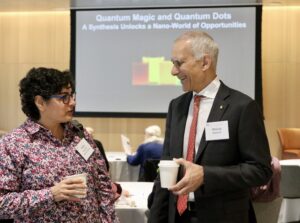A nano-world of opportunities
Breakfast with Nobel Laureate, Professor Moungi Bawendi

Dean of Science Nergis Mavalvala talks with Nobel Prize winner and MIT Professor Moungi Bawendi at the Dean's Breakfast talk on April 18, 2024. Photo: Allegra Boverman.
“You’ve seen so many of these pictures, I’m sure,” said Lester Wolfe Professor of Chemistry Moungi Bawendi, projecting a photo of bright, rainbow-colored vials against a black background onto the wall. “I’ve seen so many of these pictures!”
Along with Louis Brus and Alexei Ekimov, Bawendi won the 2023 Nobel Prize in chemistry “for the discovery and synthesis of quantum dots,” the nanoparticles depicted in the photo. Quantum dots are particles of semiconductor materials so small that their physical characteristics are determined by the laws of quantum mechanics. They fluoresce brightly in ultraviolet light and the colors of light the dots emit depends on the sizes of the particles. On the morning of April 18, he presented a talk entitled, “A Synthesis of Quantum Dots Unlocks a Nano-World of Opportunities,” to the donors, friends, and students assembled for breakfast.
The presentation chronicled the development of quantum dots from early discoveries in the 1980s, when Ekimov observed changing colors from nanoparticles frozen in glass, and Brus from nanoparticles suspended in liquid — rudimentary and “ugly” particles — to today’s iteration, refined by Bawendi, that has upgraded LED and bioimaging technology. Bawendi moved on to a slide of a transparency that he dated to the late 1980s or early 1990s, full of measurement data from early research.
During Bawendi’s postdoc with Brus at Bell Labs, he experimented with preparing the particles in pyridine and other Lewis bases, growing crystal structures. Of 20 vials, “19 were ugly; nothing happened. And one of them was magic.” An attempt using trioctylphosphine oxide created something “really sharp and beautiful.”
“At Bell Labs, it worked some of the time. Here, it just didn’t work. … By necessity, we had to reinvent the process.”
Bawendi then continued his work on the method at MIT as an assistant professor. “At Bell Labs, it worked some of the time. Here, it just didn’t work,” he recalled. What’s more, the materials were expensive, and the lab couldn’t afford to keep going through them at the rate they were without getting results. “By necessity, we had to reinvent the process.”
Bawendi and his students turned to longer chain phosphates, which were affordable and available, “not just in the truckload — in the trainload.” They eliminated an initial step of growing very little particles, instead using a rapid injection method at 300 degrees Celsius for immediate nucleation. This innovation led to Bawendi’s first paper as an assistant professor.
Initially, the dots had a quantum yield of 20 percent, meaning that of 100 photons absorbed by a particle, 20 were reemitted as a different colored light. “We thought that was amazing because before it was 0 percent,” Bawendi noted. The group quickly increased their success rate from 10 percent to 100 percent. Before, the colloidal quantum dots were protected by a metaphorical plastic bag. Now, with scientists’ ability to better control particles, build crystals, and produce materials, they could be protected by a metaphorical hard shell and a plastic bag.
With their new method, Bawendi and his students synthesized quantum dots uniform in size and color. “They’re really bright and they’re really small and they make light. They’ve got to be good for something,” said Bawendi. And indeed they were — in addition to a Nobel Prize, the quantum dots have already led to advances in biomedical imaging, cell labeling, and lighting displays like televisions, with potential advances in solar cells, electronics, photocatalysts, and spectrometers on the horizon.
Sarah Costello and Jesse Feiman | School of Science